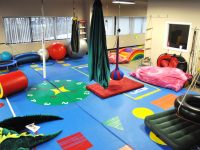Being a parent brings you lots of joy. However, if your child is struggling with a sensory processing disorder (SPD), there is a whole range of other challenges you may be facing. Everyday environments often don’t accommodate children with SPD.
For instance, if you have a child whose over-sensitive, they may find things like physical touch, light, and food to be too stimulating. But, if they’re under-sensitive, they may crave this stimulation and not get enough of it to meet their needs.
This is where indoor sensory gyms come in. These gyms are a great place for children with SPD to receive the right amount of stimulation they need and have fun while doing it.
Several elements you’ll find in an indoor sensory gym include:
Vestibular
This is movement stimulation which your child can gain through trampolines, swings or zip lines. Spinning, jumping, rocking and swinging are vital to children not just for the exercise and fun, but also to organize and regulate their bodies and sensory systems. Vestibular input is an essential part of sensory integration therapy.
Visual
If your child is sensitive to light, indoor sensory integration gyms provide the right type of lighting so they can enjoy what their activity they’re focused on.
Auditory
Auditory receptors are in a child’s ears. They may often hear sounds that overstimulate them and hinder their ability to play. On the contrary, some children experience sounds differently in that they enhance their experiences. Sensory gyms provide children with different sound opportunities.
Taste and Smell
Many sensory gyms use natural elements like flowers and plants that stimulate your child’s sense of smell helping them engage in and enjoy their overall experience.
You may have a child who seems to taste everything they see or has a hard time tasting unfamiliar tastes. Sensory gyms provide children with snacks and food that helps them to experience different tastes. They also give children the opportunity to taste and explore different foods in their own calm and safe way with no motives or stigmas present.
Talk to your child’s San Diego pediatric occupational therapist to see if a sensory gym can help improve your child’s development. These gyms are just the right environment for children who get overwhelmed or stressed and in play centers and school environments that other children have no problems with because they’re designed for children with SPD.
